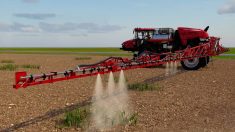Even worse, many producers report that their extra efforts in getting calves preconditioned to go into a feedlot are not rewarded.
A recent survey by Farm Credit Canada shows consumer demand doesn’t rate high on the radar screen of most producers. Consumer demand ranked last when producers and agribusiness owners were asked what factors were driving any changes they planned to make to their operations this year.
FCC has also published an edition of Knowledge Insider on its website that delineates consumer trends. In general, consumers increasingly want healthy, convenient food that is safe to eat. And there’s increasing concern about the environmental impact of food choices.
Read Also

Farm equipment sales sector sees significant structural changes
Farming equipment sales have been declining for a number of years now, and one industry professional believes structural changes in the industry are needed to curb that trend.
Some of the specific trends include populations becoming more ethnically diverse and that presents opportunities for specific food products.
Don’t producers want to advance their businesses by tapping into what the marketplace wants? Why aren’t these trends of interest?
It’s because most of us don’t actually sell directly to consumers.
Producers who participate in farmers markets sell directly to consumers and so do some direct marketers. However, most producers on the Prairies sell to intermediaries.
There’s room for more direct marketing, but it will always be a minor part of our agriculture. With a huge land base and only a small population, we’ll always rely on the export market. Most farmers here never meet the end consumers of their products.
On grains, oilseeds and specialty crops we worry about the grading standards because that’s how the products are valued. Many years ago, premiums were established for higher levels of protein in wheat and durum. That market signal has become integrated into decision-making on the farm.
On canola, no system has been established to pay producers for higher oil content, so in most cases producers don’t take steps to maximize their oil content.
On feeder calves going to market, buyers seem to care about the colour and the size, but there isn’t much attention paid to genetics. Cow-calf producers rarely get feedback from the marketplace on whether their calves grow up to hit the top grades. Even worse, many producers report that their extra efforts in getting calves preconditioned to go into a feedlot are not rewarded. At the auction market, the calves are sorted by weight and mixed with calves from other producers. The buyer pays the same price for all of them.
Will producers receive any reward for the extra effort in age verifying their calves? Opinions vary. Some say that age-verified calves won’t command a higher price, but calves that aren’t age verified will be discounted.
While there are markets such as Japan that want age assurances, some argue that there’s no need to age verify all cattle to serve these markets.
Academics talk a lot about value chains and how information should be shared along all the steps of the marketing system in order to maximize value. Great concept. In the real world, this rarely happens.
There’s no doubt that consumer preferences are changing and there’s no doubt this will end up having a huge impact on all of agriculture – farmers included.
But you can’t blame most producers if they glaze over when someone starts detailing the latest food consumption trends. Unless a producer is going to jump into some form of direct marketing, it’s difficult to make good use of the information.
Quality specifications and price parameters do matter and producers follow these closely. If a company wants a specific variety of lentils or durum or a specific quality, farmers become interested when the price becomes attractive relative to other options.
Agriculture may be consumer driven, but consumer signals filter back to the farm through many intermediaries. We assume the price incentives and rules are indicative of what consumers are demanding, but unfortunately most of us are far removed from the end users.
Kevin Hursh is a consulting agrologist and farmer based in Saskatoon. He can be reached at[email protected]














